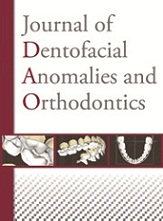No CrossRef data available.
Article contents
The biteplate facebow: a clinical and cephalometric study
Published online by Cambridge University Press: 18 October 2010
Abstract
Introduction: The biteplate facebow includes a metallic occlusal plate that rests between the upper and lower incisors that is designed to correct the incisal overbite. The objective of this study is to evaluate the skeletal and dental effects of this appliance.
Patients and method: We chose thirty patients, sixteen boys and 14 girls, who had Class II malocclusions associated with a deep anterior overbite for this study. None of them had had teeth extracted as an adjunct to therapy. The only orthodontic appliance they wore was the facebow biteplate, for fourteen hours a day on the average, until their Class II molar relationship was corrected.
Results: After correction of the Class II molar relationship, we observed statistically significant before and after differences for both the incisal deep bite and the labial inclinations of the maxillary and mandibular incisors. We also noted skeletal changes at the close of treatment, notably of the mandibular plane and of point A, but they were not significant.
Conclusion: With this appliance, Class II Angle malocclusions with deep anterior overbites can be treated in a single stage, essentially by movements of teeth.
Keywords
- Type
- Research Article
- Information
- Journal of Dentofacial Anomalies and Orthodontics , Volume 11 , Issue 1: Varia , March 2008 , pp. 45 - 59
- Copyright
- © RODF / EDP Sciences


